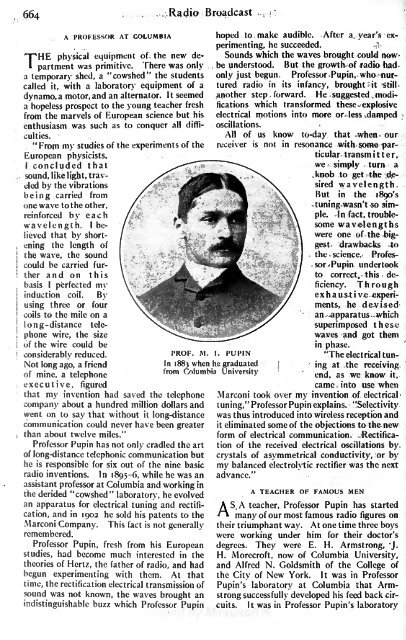Radio Broadcast - 1925, February - 113 Pages ... - VacuumTubeEra
Radio Broadcast - 1925, February - 113 Pages ... - VacuumTubeEra
Radio Broadcast - 1925, February - 113 Pages ... - VacuumTubeEra
You also want an ePaper? Increase the reach of your titles
YUMPU automatically turns print PDFs into web optimized ePapers that Google loves.
forward.<br />
66 4 Rg.dio <strong>Broadcast</strong><br />
THE<br />
A<br />
PROFESSOR AT COLUMBIA<br />
physical equipment of the new department<br />
was primitive. There was only<br />
a temporary shed, a "cowshed" the students<br />
called it, with a laboratory equipment of a<br />
dynamo, a motor, and an alternator. 1 1 seemed<br />
a hopeless prospect to the young teacher fresh<br />
from the marvels of European science but his<br />
enthusiasm was such as to conquer<br />
all difficulties.<br />
" From my studies of the experiments of the<br />
European physicists,<br />
1; concluded that<br />
sound, like Ijght, traveled<br />
by the vibrations<br />
being carried from<br />
one wave to the other,<br />
reinforced by each<br />
wavelength. believed<br />
that by I shortening<br />
the length of<br />
the wave, the sound<br />
could be carried further<br />
and on this<br />
basis I<br />
perfected my<br />
induction coil. By<br />
using three or four<br />
coils to the mile on a<br />
Professor Pupin has not only cradled the art<br />
of long-distance telephonic communication but<br />
he is<br />
responsible for six out of the nine basic<br />
radio inventions. In 1895-6, while he was an<br />
assistant professor at Columbia and working in<br />
the derided "cowshed" laboratory, he evolved<br />
an apparatus for electrical tuning and rectification,<br />
and in 1902 he sold his patents to the<br />
Marconi Company. This fact is not generally<br />
remembered.<br />
Professor Pupin, fresh from his European<br />
studies, had become much interested in the<br />
theories of Hertz, the father of radio, and had<br />
begun experimenting with them. At that<br />
time, the rectification electrical transmission of<br />
sound was not known, the waves brought an<br />
indistinguishable buzz which Professor Pupin<br />
hoped to make audible. After a year's experimenting,<br />
he succeeded.<br />
Sounds which the waves brought could nowbe<br />
understood. But the growth of radio had<br />
only just begun. Professor -Pupin, who nurtured<br />
radio in its infancy, brought it still<br />
another step<br />
.<br />
He suggested .modifications<br />
which transformed these explosive<br />
electrical motions into more or less ^damped<br />
oscillations.<br />
All of us know to-day that when our<br />
wavelength.<br />
receiver is not in resonance with some particular<br />
transmitter,<br />
we simply turn a<br />
knob to get the desired<br />
But in the 1890'$<br />
tuning- wasn't so simple.<br />
In fact, troublesome<br />
wavelengths<br />
were one of the biggest<br />
drawbacks -to<br />
the science. Professor<br />
>Pupin undertook<br />
to correct, this de-<br />
Through<br />
ficiency.<br />
e x h a u s t i ve experiments,<br />
he devised<br />
an ^apparatus which<br />
long-distance telephone<br />
sup-erimposed these<br />
wire, the size<br />
waves and got them<br />
of the wire could be<br />
phase.<br />
considerably reduced.<br />
PROF. M. I. PUPIN<br />
"The electrical tuning<br />
Not long ago, a friend<br />
1883 when he graduated<br />
of mine, a from Columbia receiving<br />
University<br />
telephone<br />
end, as we know it.<br />
executive, figured<br />
came into use when<br />
that my invention had saved the telephone Marconi took over my invention of electrical<br />
company about a hundred million dollars and tuning," Professor Pupin explains. "Selectivity<br />
went on to say that without it<br />
long-distance was thus introduced into wireless reception and<br />
communication could never have been greater<br />
it eliminated some of the objections to the new<br />
than about twelve miles."<br />
form of electrical communication. Rectification<br />
of the received electrical oscillations by.<br />
crystals of asymmetrical conductivity, or by<br />
my balanced electrolytic rectifier was the next<br />
advance."<br />
A TEACHER OF FAMOUS MEN<br />
has started<br />
AS, A teacher, Professor Pupin<br />
many of our most famous radio figures on<br />
their triumphant way. At one time three boys<br />
were working under him for their doctor's<br />
degrees. They were E. H. Armstrong, 'J.<br />
H. Morecroft, now of Columbia University,<br />
and Alfred N. Goldsmith of the College of<br />
the City of New York. It was in Professor<br />
Pupin's laboratory at Columbia that Armstrong<br />
successfully developed his feed back circuits.<br />
It was in Professor Pupin's laboratory
















